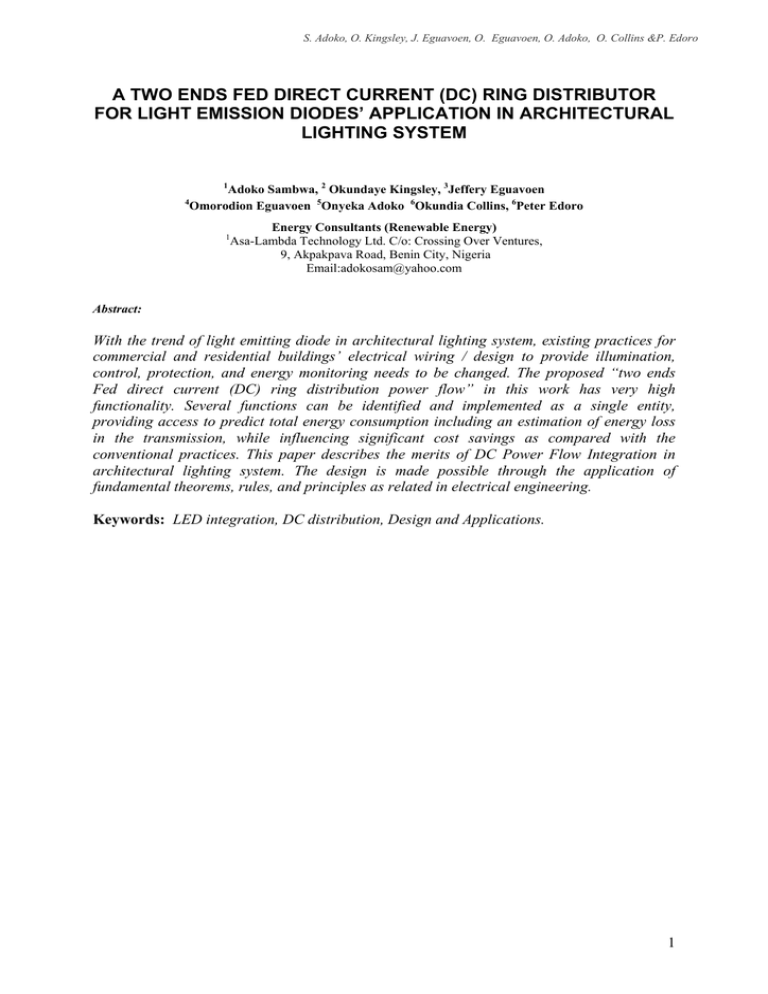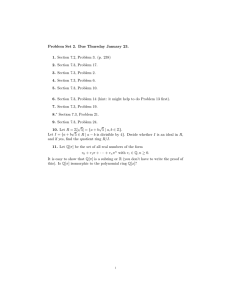
S. Adoko, O. Kingsley, J. Eguavoen, O. Eguavoen, O. Adoko, O. Collins &P. Edoro
A TWO ENDS FED DIRECT CURRENT (DC) RING DISTRIBUTOR
FOR LIGHT EMISSION DIODES’ APPLICATION IN ARCHITECTURAL
LIGHTING SYSTEM
1
Adoko Sambwa, 2 Okundaye Kingsley, 3Jeffery Eguavoen
4
Omorodion Eguavoen 5Onyeka Adoko 6Okundia Collins, 6Peter Edoro
Energy Consultants (Renewable Energy)
Asa-Lambda Technology Ltd. C/o: Crossing Over Ventures,
9, Akpakpava Road, Benin City, Nigeria
Email:adokosam@yahoo.com
1
Abstract:
With the trend of light emitting diode in architectural lighting system, existing practices for
commercial and residential buildings’ electrical wiring / design to provide illumination,
control, protection, and energy monitoring needs to be changed. The proposed “two ends
Fed direct current (DC) ring distribution power flow” in this work has very high
functionality. Several functions can be identified and implemented as a single entity,
providing access to predict total energy consumption including an estimation of energy loss
in the transmission, while influencing significant cost savings as compared with the
conventional practices. This paper describes the merits of DC Power Flow Integration in
architectural lighting system. The design is made possible through the application of
fundamental theorems, rules, and principles as related in electrical engineering.
Keywords: LED integration, DC distribution, Design and Applications.
1
S. Adoko, O. Kingsley, J. Eguavoen, O. Eguavoen, O. Adoko, O. Collins &P. Edoro
1. INTRODUCTION
In the eve of increasingly energy crisis, mostly in Africa Sub-Sahara, DC distribution
network in interior lighting system will play a key role in energy charging and energy
utilization. This paper investigates the reliability and suitability of a ring DC distribution
topology for an interior lighting system. The implementation of DC power distribution
architecture is then proposed, analyzed and simulated as an efficient method of power
transmission for architectural lighting system’s applications. The authors are motivated by the
following facts. – absence of reactive power in a DC feeder, the possibilities of an efficient
integration of other sources of power within the same network, the fact that adopting DC
distribution, more sub-distributions can be created within the main frame of DC topology as
shown in figure 1.
Figure 1: DC distribution topology
If the trend to halve or reduce the energy consumption is real, the need to adopt technological
option becomes a reality which needs special consideration. Light emitting diode (LED) has
paved way for such realization to be possible. But, considering the fact that light emitting
diodes are semi-conductors, DC distribution is an ideal medium to transport energy to the
point where it is converted to illumination.
Interestingly, the growth in energy demand remains incompatible with renewable source of
energy [1]. And, if this postulation is true, the best practice for efficiently utilize energy,
needs to be considered with the utmost urgency it may deserve. When considering the three
drivers of energy demand, Mark Diesendorf pointed at the technology choice to be the most
probable solution to tackle the energy situation [2]. Hence, the combination of LEDs in DC
distribution will guaranty reliability and efficiency [3].
2. DC CONFIGURATION NETWORK TOPOLOGY
There exist various configurations of DC distribution architectures. This paper elaborates on
a ring DC distribution network. This, has proved to be a cost-efficient solution to enhance
reliability and suitability of the distribution. Consequently, this paradigm will open new
possibilities for LED integration in architectural lighting system [4]. In this paper, the ring
distribution network has been simulated to justify the efficiency and reliability of this
concept, which by definition; it is a process of finding the voltages across, and the currents
through each component in the network. Assuming that the components of such network are
all linear, Kirchhoff’s law of voltages and currents will be the most suited for this analysis.
The nature of loads to be used in this method has greatly influenced our choice of method [5].
2
S. Adoko, O. Kingsley, J. Eguavoen, O. Eguavoen, O. Adoko, O. Collins &P. Edoro
A ring network topology as shown in figure 2 was chosen based on the advantages attached
to it, that is, a network in which all devices (loads) are connected to one another in the shape
of a closed loop.
Figure 2: Ring topology network
3. ANALYSIS / SIMULATION
In electrical engineering system’s design with the simulation components of direct current
(DC) power flow, optimization of the operating performance of the entire network is an
elementary perceptive approach, using the existing rules and theories as detailed in electrical
technology for the transmission as against the conventional (AC) method. It is recognized
that, the performance of energy consumption using LED as load, has a linear and constrained
nature with respect to the design variables as far as illumination is concerned [7]. When those
components are integrated and implemented in a network for operation, it would manifest
such interconnectivity between the system performance and the above mentioned
constrained. Such inherent imperfection as heat, being emitted by LED can only be tackled
by the manufacturers. Therefore, this paper demonstrates an evolutionary algorithm by the
implementation of DC power flow using network fed in both ends.
Figure 3: Ring distribution feeder with equal voltage in both ends.
The main scenario of the measurement procedure is the current allocations and the voltage
drop along the transmission network. The current allocations seems very trivial issues but,
with the existing techniques in which the network will be dismantled and reconfigured using
the Kirchhoff’s law as shown in Figure 4.
3
S. Adoko, O. Kingsley, J. Eguavoen, O. Eguavoen, O. Adoko, O. Collins &P. Edoro
Ia + Id – Ib – Ic – Ie = 0 … … 2
Figure 4: Kirchhoff’s law of currents and voltages.
The fundamental reality to envail in this analysis is the current distribution, voltage drop, and
power losses, among others.
Adopting ring distribution network, there, exist a sizeable number of opportunities to
accommodate sub-distributions within the main network, as shown in figure 5.
Figure 5: Ring distribution/sub-distribution topology.
Figure5: shows a two-wire DC network, distributed randomly along a closed circuit which is
fed a t one or more than one point. Mathematically, when calculating its voltages distribution,
it is assume as consisting of a series of open distributions fed at both ends, and having subdistributions within the same platform [8], great economy in copper can be affected.
Figure 6: Parallel connected two end feeders
4
S. Adoko, O. Kingsley, J. Eguavoen, O. Eguavoen, O. Adoko, O. Collins &P. Edoro
4. ANALYSIS
The fundamental components to be determined in the analysis of ring distribution are the
voltages drop, power losses in the transmission, and the currents passing through each load.
The load are fed at both ends of the distribution with equal voltages as shown in figure 7 (a)
and (b)
(a)
(b)
Figure 7: A ring distribution with equal feeds.
When considering a DC network fed at both ends with equal voltages, there is a point in the
network where the voltage drop is higher than the rest; such point will be considered with
great attention in this analysis.
Considering the ends E1 AND E2 which represent the distribution feeders with equal voltages,
it is expected that there will be potential drop along the transmission, from E1 and onward,
reaching a minimum value.
In guise of analysis, let assume that all currents tapped off between points E1 and B will be
supplied from E1, while those tapped off between E2 and B will be supplied from E2.
Point B is the meeting point of currents from source E1 and E2, named y and z respectively.
Ideally, the distribution behaves as if it was cut off into 2 portions, as shown in figure 8.
Figure 8: Ring distribution as two identical distributions.
5
S. Adoko, O. Kingsley, J. Eguavoen, O. Eguavoen, O. Adoko, O. Collins &P. Edoro
When configurating the network in this pattern, the fundamental objective will be to identify
and measure the necessary parameters.
In the ring distribution configuration, the knowledge of actual distance between the taping off
points and the power source is necessary. Equally, the internal resistance of the conductor
needs to be identified as shown in figure 9 where a ring distribution of length 400m, of two
wires of 0.2ohms per 1,000m resistance, having the loads a tapped off at point B,C and D as
shown in figure 9. The power source is 24V
(a)
Figure 9: Ring distributions simulation
The distribution is fed at point A. the voltage drop at B C and D can be determined as follow:
The current crossing point D is I.
70 I + 90 (I-5) + 80 (I-12) + 60 (I-22) = 0
300I = 2,730 - I = 9.1 amps
4.1
Voltage Drops
-
Drop in section AD = 2 (9.1 X 70 X 0.2/1000) = 0.25V
Drop in section DC = 2 (4.1 X 90 X 2/1,000) = 0.15V
Drop in section CB = 2[(12-9) X 80 X 0.2/1,000]=0.1V
Drop in section BA = 2[(12.9) X 60 X 0.2/1000] =0.15V
4.2
Energy Loss In The Transmission
Energy Loose in the transmission
Between D and C, 0.15 X 4.1 = 0.615 ω
Between C and B, 0.1 X 2.9 = 0.29 ω
Between B and A, 0.15 X 12.9 = 1.935 ω
Between A and D
Total Loss = 2.840 ω =
PLOSS
Power at the source is P1 = V.I = 528 ω
Power at the end of the transmission is P2 = P1 – PLoss
= 528 – 4.0852
= 523.915
…
…3
6
S. Adoko, O. Kingsley, J. Eguavoen, O. Eguavoen, O. Adoko, O. Collins &P. Edoro
Efficiency Of The Network
P2
Efficiency η =
x 100
P1
523.915
=
x 100 = 99.23%
528
4.3
…
…4
Figure 10: Current distribution Network
Verifications of the result using Kirchhoff’s laws.
I4, + I6 = I5
4, 1 + 2.9 =
7A
=>
I8 = Iy + I6
12.9 = 10 + 2.9
=>
I1 = I2 + I8
22 = 9, 1 + 12.9
=>
I2 = I3 + I4
9.1 = 5 + 4.1
=>
7
S. Adoko, O. Kingsley, J. Eguavoen, O. Eguavoen, O. Adoko, O. Collins &P. Edoro
RESULTS:
The authors opined that DC distribution will soon be significant of importance as regard its
reliability, efficiency, and adaptability. These qualities will be considered fundamental if the
issue of energy consumption in architecture lighting system remains a problem to be solved.
This network proved that, in adopting DC distribution topology, it is possible to determine
and predict the actual energy consumption. The paper is supported by the efficiency and
reliability offered as well as the ability to support and integrate mix source of energy and
storage technologies in a single bus bar. The intended solution is that the energy dissipation
and consumption will reduce. Equally, the source of emissions will reduce by making use of
renewable source of energy.
6. APPLICATIONS
The adoption of DC distribution topology is influenced by the absence of reactive power in
DC source; the possibility to have an efficient and easy integration of additional sources
(power) to the same network has been an added factor.
At this platform, DC power distribution architecture will out-weight AC type as far as
reliability, efficiency and susceptibility is concerned. As was pointed that, reliability and
efficiency of a typical power distribution can be improved by decreasing the number of
power conversion required within the crucial current path from the source to the load [6].
To effectively make use of the DC power distribution, there is urgent need to harmonize the
supply of the loads (LEDs) to DC source. It will be then confirmed that, a move to DC
distribution topology is justified when efficiency and lossless distribution are concerned. It
will then be appreciated to consider DC distribution architecture when considering
integrating LEDs in interior lighting system, but significant compatibility issued among
difference manufacturers needs to be aligned so that LEDs can exhibit its full potential as
light source.
8
S. Adoko, O. Kingsley, J. Eguavoen, O. Eguavoen, O. Adoko, O. Collins &P. Edoro
The authors opine that, DC distribution architecture remains the most fundamental method or
process for powering LEDs in architectural lighting system due to its compatibility,
flexibility, and suitability. But the wide spread of DC distribution will some gallops as far as
its implementation is concerned. This is the fact that there is no single standard for DC power
supplies. The development of DC-DC converters has brought a corrective measure and it has
widened the trend of DC distribution beyond any existing obstacle.
7. CONCLUSION
With the rush of LEDs integration as direct replacement to the existing light source there is
tendency from various manufacturers to have LEDs’ plug in as AC load. This trend, although
being retrogressive, has facilitated the use of converter in the same compartment with LED.
Such configuration may result to an excessive power loss due to AC – DC conversion.
However, the authors of this paper strongly recommended that DC distribution can be
advantageous in multiple aspects and predicted a massive widespread adoption of DC
distribution topology as far as LEDs application is concerned.
Supporting Neil Rasmussen [9], who stipulated that “eliminating power conversion stages
will increase electrical efficiency. In other words, adopting DC distribution will enhance
electrical flexibility of the entire network. This has equally been confirmed by Rudy Kraus
[10] that the effect of using direct current is to reduce the number of voltages and conversion
between AC and DC, which will makes the overall system more efficient. The clear
advantages of DC distribution will lead to the use of this topology for future lighting in
buildings. This will be translated to a system having: - lower capital acquisition cost [11],
higher efficiency, and high reliability [12] as confirmed in the present paper.
The most important prerequisite for the distribution of DC power flow, integrated with solar
energy in light emitting diode’s applications, is the accurate measurement of the parameters.
These parameters need to be calculated with some level of precision so that an algorithm may
be established for larger and more complex systems.
However, bad analysis of the distribution of DC power flow with inconsistent measurements
such as in coherent satisfaction of the Kirchhoff’s current and voltage law will result to a very
expensive project or project which may not resist the test of time during practical
implementation.
In spite of the above, DC distribution power flow in LED’s application, integrated with
sophisticated controllers, light sensors and drivers, may provide acceptable result to the end
users.
8. ACKNOWLDEGEMENT
The authors acknowledge with thanks for the financial and moral contribution from
“Kesslink Global Resources, Musafa & Scar Ltd, and Desreell Options Investment Ltd”.
9
S. Adoko, O. Kingsley, J. Eguavoen, O. Eguavoen, O. Adoko, O. Collins &P. Edoro
9. REFERENCE
[1]
Adoko et al (2008) “Reduction of Energy consumption in building requires a
comprehensive Electrical Design of an integrated interior lighting system using light
emitting Diode (LED)”. 7th International Conference on sustainable Energy
Technologies, South Korea, Seoul (2008)
[2]
Mark Diesendof (2007) “Green House solutions with Sustainable Energy”, university
of New South Wales Press Ltd, University of New South Wales. Sydney NSW 2052.
Australia
[3.]
Adoko et al (2008) “Effective Paradigm for direct current (DC) distribution using
light emitting diodes (LEDs) in architectural lighting system”. The 3rd Regional
World Renewable Energy Congress 10th Arab International Conference. Kuwait City,
Kuwait 2008.
[4.]
Ibid
[5.]
Nilsson Jan et al “Electric circuits PP 112 – 113” Pearson prentice Hall 2007
[6.]
E. C. W. de Jong et al “DC power distribution
www.leomardo_energy.ord/drupal/book/export/htm//22222
[7.]
Adoko et al (2008) “Reduction of Energy consumption in building requires a
comprehensive Electrical Design of an integrated interior lighting system using light
emitting Diode (LED)”. 7th International Conference on sustainable Energy
Technologies, South Korea, Seoul (2008)
[8.]
B. L Theraja et al (1995): A text – book of electrical technology Nirja construction of
Development co (P) Ltd Ram Niger, New Delhi – 110055.
[9.]
Neil Rosmussen (2008), “AC Versus DC, power distribution in the 21st century”
Network knowledge, www.betanetworkasis.net/article.php?id_article
[10.]
Rudykraus (2008). “Validus taps DC power to save energy in data centers” posted by
Martin Lamonica, 27/01/2008. www.validustaps DC power to save energy in data
centers Green Tech-CENT News 6/19/2008.
[11.]
Marcel P. J et al (1999) “Solid State High Voltage DC power distribution and control”
proceeding of the 1999 particle accelerator conference, New York, 1999.
[12.]
Ibid.
for
server
farms”
10
S. Adoko, O. Kingsley, J. Eguavoen, O. Eguavoen, O. Adoko, O. Collins &P. Edoro
Dr. Adoko Sambwa M.M, born in Democratic Republic of
Congo. He studied power electronics at the University of
Lagos, Nigeria, obtaining his Ph.D in 1994 in the University
of Benin, Nigeria.
He is the Director of Asa-Lambda Technology, an Energy
Consultant firm based in Nigeria. He is a member of
International Solar Energy Society (ISES), Africa Wind
Energy Association, and the Nigeria Society of Engineers.
His research areas have included re-adaptation, reconfiguration of new technologies to the
rural dwellers. He has sizeable number of papers to his merit. He has been with his present
company since 1994, working as a development engineer for rural electrification.
Renewable Energy is considered as a pivot in which the matrices of development will rely
upon and the Sub-Saharan Africa has much to gain.
11



